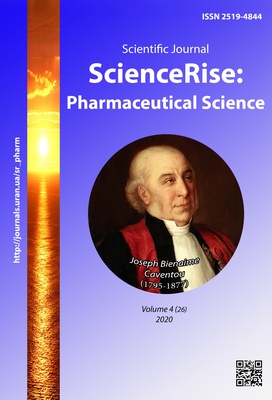Study of the morphological and anatomic signs of the flowers of the chrysanthemum hortorum bailey sort pectoral (pharmacognostic analysis)
DOI:
https://doi.org/10.15587/2519-4852.2020.210828Keywords:
morphological structure, anatomical structure, inflorescences, Chrysanthemum × hortorum Bailey, cultivar PectoralAbstract
The aim. To study of the morphological and anatomical features of the structure of inflorescences of Chrysanthemum × hortorum Bailey, variety Pectoral.
Materials and methods. The inflorescences of Chrysanthemum × hortorum Bailey, cultivar Pectoral were used for the analysis. The raw materials were harvested in the phase of mass flowering of plants in September-October 2019 at the experimental plots of the department of floral and ornamental plants of the National Botanical Garden named after M.M. Grishko of the National Academy of Sciences of Ukraine in Kyiv.
Results. The investigated inflorescences are represented by bright orange double baskets, consisting of seated semiflorets and disk flowers arranged spirally on a convex bare anthoclinium. The involucrum of Chrysanthemum × hortorum Bailey inflorescences of the Pectoral variety has a dense structure with elongated leathery leaves. The marginal flowers of the anthodium are red-orange, pseudo-ligate female; the middle flowers are yellow, tubular, bisexual. The apex and edge of the epidermal cells of pseudo-ligate flowers are characterized by papillary growth and slight folding of the cuticle; at the base of the corolla lingula there are cells with calcium oxalate crystals in the form of small druses. The anatomical structure of tubular flowers is characterized by essential oil glands, typical for the Asteraceae family. The epidermis of the wrapper leaves is represented by oval cells with numerous essential oil glands and large surface outgrowths.
Conclusions. The main diagnostic morphological and anatomical features of the inflorescences of Chrysanthemum × hortorum Bailey cultivar Pectoral have been established, which can be further used in the identification of new medicinal plant materials
References
- Demydiak, O. L. (2014). Vmist zhyrnykh ta orhanichnykh kyslot u kvitkakh i lystkakh khryzantemy sadovoi bahatorichnoi. Farmatsevtychnyi chasopys, 3, 27–31.
- Marchyshyn, S. M., Harnyk, M. S., Polonets, O. V., Ambok, Kh. Yu. (2020). Dosvid vykorystannia dekoratyvnykh roslyn u medychnii praktytsi (ohliad literatury) Perspektyvni napriamky naukovykh doslidzhen likarskykh ta efirooliinykh kultur, 219–225.
- Trautwein, K. S., Klemeshova, K. V. (1970). The history of studying chrysanthemum (Chrysanthemum × hortorum Bailey) in the Russian Research Institute of Floriculture and Subtropical Crops. Subtropical and Ornamental Horticulture, 64, 26–33. doi: http://doi.org/10.31360/2225-3068-1970-64-26-33
- Antonova, K. S., Klemeshova, K. V. (2017). Kultura Chrysanthemum × hortorum Bailey vo Vserossiiskom nauchno-issledovatelskom institute tsvetovodstva i subtropicheskikh kultur i perspektivy ee izucheniia. Plodovodstvo i iagodovodstvo, 51, 121–129.
- Novye sorta khrizantemy vo vlazhnykh subtropikakh Chernomorskogo poberezhia Krasnodarskogo kraia. Subtropicheskoe i dekorativnoe sadovodstvo. (2016). Sochi: VNIITSiSK, 90–94.
- Kozmenko, N. P. (2015). Melkotsvetnye khrizantemy. Novinki dlia subtropicheskoi zony Rossii. Tsvetovodstvo, 1, 12–15.
- Ivanova, V. (1998). Morphological Characteristics of Chrysanthemum Plants, One-; Two-Or Three Stem Formated. Progress in Botanical Research, 313–316. doi: http://doi.org/10.1007/978-94-011-5274-7_71
- Hoang, T. K., Wang, Y., Hwang, Y.-J., Lim, J.-H. (2020). Analysis of the morphological characteristics and karyomorphology of wild Chrysanthemum species in Korea. Horticulture, Environment, and Biotechnology, 61 (2), 359–369. doi: http://doi.org/10.1007/s13580-019-00222-9
- Gao, K., Song, X., Kong, D., Dai, S. (2020). Genetic Analysis of Leaf Traits in Small-Flower Chrysanthemum (Chrysanthemum × morifolium Ramat.). Agronomy, 10 (5), 697. doi: http://doi.org/10.3390/agronomy10050697
- Burmistrova, N. O., Fabryka, M. R. (2020). Chrysanthemum coronarium L. v kolektsii Natsionalnoho dendrolohichnoho parku «Sofiivka» NAN Ukrainy, Perspektyvni napriamky naukovykh doslidzhen likarskykh ta efirooliinykh kultur, 21–23.
- Chinese Pharmacopoeia Commission (2010). Pharmacopoeia of the people's Republic of China, 292.
- Duke, J. A. (2002). Handbook of medicinal herbs. CRC PRESS, 193–194.
- Sambukova, T. V., Ovchinnikov, B. V., Ganapol’sky, V. P., Yatmanov, A. N., Shabanov, P. D. (2017). Prospects for phytopreparations (botanicals) use in modern pharmacology. Reviews on Clinical Pharmacology and Drug Therapy, 15 (2), 56–63. doi: http://doi.org/10.17816/rcf15256-63
- Marchishin, S. M., Demidiak, O. L., Dakhim, І. S., Berdei, T. S., Kozir, G. R. (2015). Research of polysaccharide complexes from asteraceae family plants. ScienceRise, 10 (4 (15)), 31–36. doi: http://doi.org/10.15587/2313-8416.2015.52002
- Polonets, O. V. Marchyshyn, S. M., Sira, L. M., Demydiak, O. L. (2018). Morphological and anatomical characteristics of leaves of chrysanthemum garden perennial varieties Belgo and Pectoral. Pharmaceutical review, 2, 17–22.
- Marchyshyn, S., Polonets, O., Zarichanska, O., Garnyk, M. (2017). GS/MS analysis of fatty acids in flowers and leaves of Chrysanthemum×hortorum Bailey Belgo and Pectoral’ variants. The Pharma Innovation International Journal, 6 (11), 463–466.
- Marchyshyn, S. M., Polonets, O. V., Garnyk, M. S., Zarichanska, O. V. (2019). Volatile compounds of garden chysanthemum (Сhrysanthemum×hortorum bailey) variant pectoral. Fitoterapia, 3 (3), 38–42. doi: http://doi.org/10.33617/2522-9680-2019-3-38
- Marchyshyn, S. M., Demydiak, O. L., Polonets, O. V., Harnyk, M. S. (2016). Doslidzhennia fenolnykh spoluk khryzantemy sadovoi bahatorichnoi (Chrysanthemum × hortorum Bailey). Medychna ta klinichna khimiia, 18 (2), 48–53.
- Marchyshyn, S. M., Polonets, O. V., Harnyk, M. S., Demydiak, O. L. (2017). Elementnyi sklad kvitok ta lystkiv khryzantemy sadovoi bahatorichnoi (Chrysanthemum × hortorum Bailey). Ukrainskyi biofarmatsevtychnyi zhurnal, 5 (52), 46–49.
- Derzhavna farmakopeia Ukrainy. Vol. 3 (2014). Kharkiv: Derzhavne pidpryiemstvo Ukrainskyi naukovyi farmakopeinyi tsent yakosti likarskykh zasobiv, 724.
- Derzhavna farmakopeia Ukrainy. Vol. 1 (2015). Kharkiv: Derzhavne pidpryiemstvo Ukrainskyi naukovyi farmakopeinyi tsent yakosti likarskykh zasobiv, 1126.
- Furst, G. P. (1979). Metody anatomo-gistokhimicheskogo issledovaniia rastitelnykh tkanei. Moscow: Nauka, 154.
- Serbin, A. G., Kartamazova, L. S., Rudenko, V. P., Gontovaia, T. N. (2006). Atlas po anatomii rastenii. Kharkiv: Kolorit, 86.
- Hajibagheri, N. (2003). Electron Microscopy. Methods and Protocols. Methods In Molecular Biology. Totowa: Humana Press, 284.
- Gao, K., Song, X., Kong, D., Dai, S. (2020). Genetic Analysis of Leaf Traits in Small-Flower Chrysanthemum (Chrysanthemum × morifolium Ramat.). Agronomy, 10 (5), 697. doi: http://doi.org/10.3390/agronomy10050697
Downloads
Published
How to Cite
Issue
Section
License
Copyright (c) 2020 Svitlana Marchyshyn, Olha Polonets, Myroslava Harnyk

This work is licensed under a Creative Commons Attribution 4.0 International License.
Our journal abides by the Creative Commons CC BY copyright rights and permissions for open access journals.








